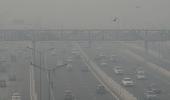Delhi recorded the worst air quality in the country on Wednesday, with the AQI recorded in the "severe" category for the first time this season, even as the central pollution watchdog attributed the deterioration to an "unprecedentedly dense" fog and described it as an "episodic event".

The city's 24-hour Air Quality Index, recorded at 4 pm every day, stood at 418, up from 334 the previous day, and it may trigger stringent restrictions under the third stage of the graded response action plan to mitigate hazardous conditions.
The Commission for Air Quality Management, however, said owing to stronger winds, the pollutant concentration is expected to start showing a declining trend Thursday onwards and the AQI is likely to move back to the "very poor" category.
"After a comprehensive review, the sub-committee decided to closely monitor the situation before implementing Stage-III of GRAP and will reassess the status on Thursday," the CAQM said in a post on X.
In another post on the microblogging platform, the CAQM said its sub-committee noted the steep rise in Delhi's AQI owing to this "episodic event" since morning.
The national capital saw its first dense fog and lowest daytime temperature of the season so far on Wednesday, trapping pollutants.
The maximum temperature in Delhi (Safdarjung) dropped from 32.8 degrees Celsius on Tuesday to 27.8 degrees Celsius on Wednesday.
Bihar's Hajipur, with an AQI of 417, had the second-worst reading in the country on Wednesday, the Central Pollution Control Board's data showed.
Of the 36 monitoring stations in Delhi, 30 recorded the air quality in the "severe" category, the CPCB said.
An AQI between zero and 50 is considered "good", 51 and 100 "satisfactory", 101 and 200 "moderate", 201 and 300 "poor", 301 and 400 "very poor", 401 and 450 "severe" and above 450 "severe plus".
According to the CPCB, Delhi's AQI was in the "severe" category for three days in January. On January 14, the AQI was recorded at 447, followed by 409 on January 24 as well as on January 26.
If the city's air quality remains in the "severe" category on Thursday, authorities may impose restrictions under the third stage of the GRAP, including a ban on construction and demolition activities and plying of BS-lll petrol and BS-IV diesel light motor vehicles.
According to the Centre's Decision Support System for Air Quality Management, vehicular emission was the top contributor to Delhi's pollution on Wednesday, with an estimated share of 13.3 percent.
The other prominent pollutants were PM2.5 and PM10.
PM2.5 and PM10 refer to fine particulate matters in the air, with the numbers indicating their size in micrometre.
PM2.5 are fine particles with a diameter of 2.5 micrometre or less, about the width of a human hair. These are so small that these can penetrate deep into the lungs and even enter the bloodstream, posing significant health risks.
PM10 are coarser particles with a diameter of 10 micrometre or less, about the width of 10 human hairs. While not as concerning as PM2.5, these can still irritate the airways and worsen respiratory problems. Long-term exposure to these particulate matters can increase the risk of heart disease.
According to the latest CPCB data, Delhi's annual average PM10 and PM2.5 levels were higher by 5 percent and 7 percent respectively between January 1 and November 12 against the year-ago period.
Between January 1 and November 12, the capital witnessed 116 days when the AQI was in the "poor", "very poor" or "severe" categories. The AQI on 201 days was "good", "satisfactory" or "moderate", the data showed.
LM Darlong, the head of thoracic oncosurgery at the Rajiv Gandhi Cancer Institute and Research Centre, told PTI that long-term exposure to PM2.5 poses a significant risk of lung cancer.
These fine particles can trigger mutations in the lung cells, leading to uncontrolled cell growth. Over a decade of exposure, these mutations are often linked to genes that play a key role in regulating cell division, Darlong said.
Early detection of lung cancer is critical as symptoms such as persistent cough or blood in sputum often appear only at later stages, making treatment more challenging, he added.
The fog led to limited visibility in the morning, with conditions at the Delhi airport dropping to zero. This marked a notable shift in the capital's climate and a few flights were diverted due to the low visibility, an official said.
Zero-metre visibility was recorded at the Indira Gandhi International (IGI) Airport at 8:30 am, with the Runway Visual Range varying between 125 metres and 500 metres at different locations, the India Meteorological Department (IMD) reported.
"Very dense" fog began forming around 5:30 am, casting a thick haze over various parts of the national capital, it noted.
"By morning, a heavy layer of fog blanketed the city, reducing visibility to as low as 125 metres in certain areas," an IMD official said.
The weather department has forecast a largely clear sky for Thursday, with predominant surface winds likely from the northwest at a speed of less than 6 kilometres per hour during the morning hours.
The IMD has also said smog or dense to very dense fog is expected in the morning. The wind speed will increase to less than 10 kmph from the northwest in the afternoon, decreasing to less than 8 kmph from the same direction in the evening and night. Smog, mist or moderate fog is likely in the evening and night.










